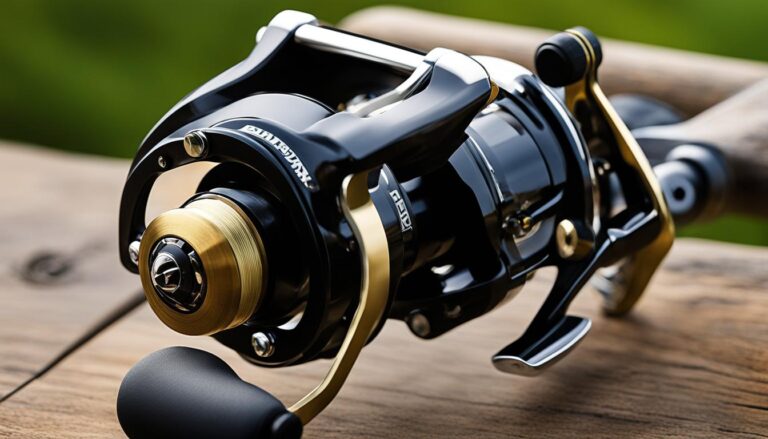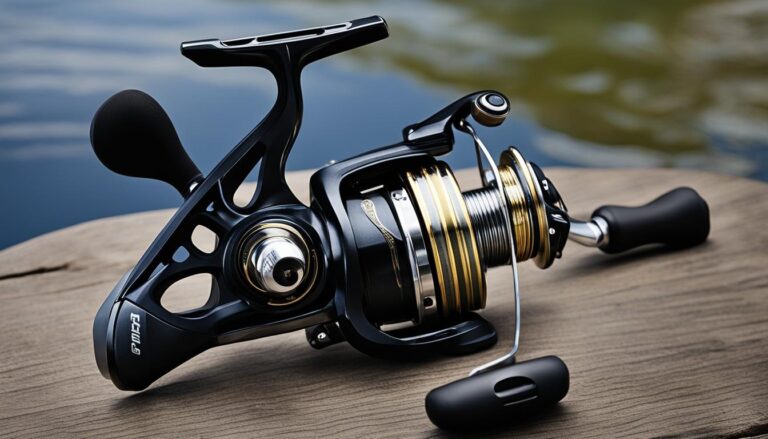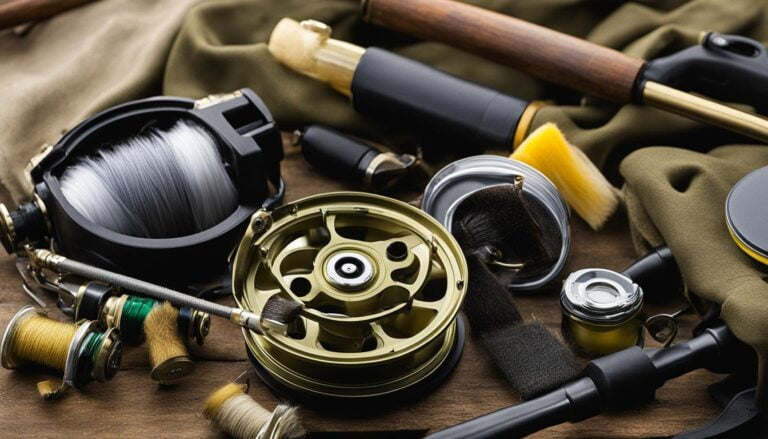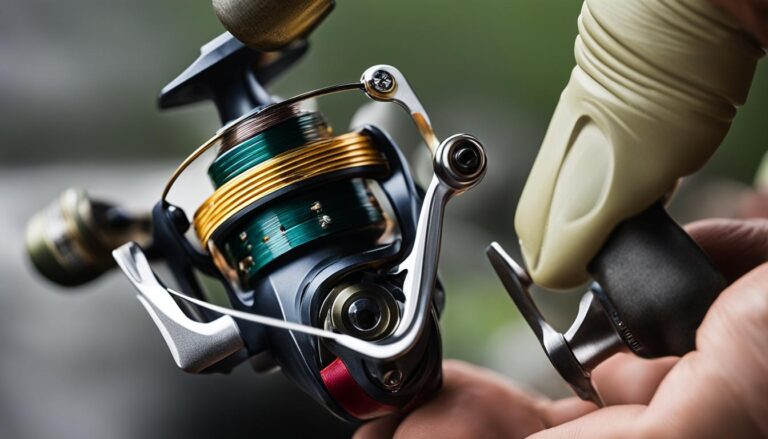Understanding Fishing Reel Drag Systems: A Complete Guide

Welcome to our complete guide on understanding fishing reel drag systems. If you’re an angler, you know that the drag system on your fishing reel is crucial for controlling the tension on the line when you’re battling a fish. It helps prevent line breakage and allows you to tire out the fish over time. In this guide, we’ll dive deep into the different types of drag systems available, how to set them up and adjust them, and why they are so important in fishing.
Key Takeaways:
- Understanding your fishing reel drag system is essential for successful fishing.
- There are different types of drag systems, including front and rear drags for spinning reels, star-shaped knobs for baitcasting reels, and magnetic drag systems.
- Properly setting up and adjusting the drag is important to ensure optimal performance.
- Drag in fishing refers to the setting that applies tension to the fishing line when a fish takes it and starts to run.
- The drag system helps prevent line breakage and allows anglers to tire out the fish.
What is Drag in Fishing?
Drag in fishing is a critical component of fishing reel technology that allows anglers to control the tension on the fishing line when a fish bites and starts to pull. It is a system that applies resistance to the line to prevent it from breaking and gives anglers the ability to tire out the fish over time. Understanding drag in fishing is essential for effectively landing and fighting fish.
There are various types of drag systems used in fishing reels, each designed to achieve the desired level of tension and control. For example, fly reels typically feature disc drag systems, while spinning reels may have front or rear drags. Baitcasting reels use star-shaped knobs or magnetic drag systems, and centerpin reels utilize dial-adjustable drag systems.
By correctly setting up and adjusting the drag system, anglers can ensure that they have the right amount of tension on the line for the fish they are targeting. This allows them to prevent line breaks while still giving the fish enough freedom to run and tire itself out. Effective use of drag can significantly enhance an angler’s fishing experience and increase their chances of success.
Table: Types of Drag Systems in Fishing Reels
| Fishing Reel Type | Drag System |
|---|---|
| Fly Reels | Disc Drag Systems |
| Spinning Reels | Front or Rear Drags |
| Baitcasting Reels | Star-shaped Knobs or Magnetic Drag Systems |
| Centerpin Reels | Dial-adjustable Drag Systems |
How to Set up and Adjust Your Fishing Drag
Setting up and adjusting the drag on your fishing reel is a crucial step in ensuring a successful fishing experience. By properly managing the drag settings, you can prevent line breakage and effectively handle different fish sizes and species. Here’s a step-by-step guide on how to set up and adjust your fishing drag.
Identify the Drag System
The first step is to identify the type of drag system your reel has. This can be a front drag, rear drag, or a star-shaped knob. Different reel models and brands may have varying drag systems, so consult the user manual or the manufacturer’s website to determine the specific drag system of your reel.
Adjust the Drag Setting
Once you’ve identified the drag system, it’s time to adjust the drag setting based on the size of the fish you’re targeting. For smaller fish, you’ll want a lighter drag setting, while larger or heavier fish will require a higher drag setting. Make sure to strike a balance between enough tension to tire out the fish and prevent line breakage.
Regularly Measure and Adjust
It’s important to regularly measure and adjust your drag settings to ensure they are always set correctly for your fishing situation. As you gain experience, you’ll develop a better understanding of the ideal drag setting for different fishing conditions and target species. Keep in mind that factors such as water conditions and the strength of the fish may require you to make adjustments during your fishing trip.

| Benefits of Properly Set Drag | Consequences of Improper Drag Setting |
|---|---|
|
|
By following these steps and regularly adjusting your drag settings, you’ll be able to optimize your fishing reel’s performance and increase your chances of a successful fishing trip. Remember to always choose the right reel drag system based on your fishing needs and the type of fish you’ll be targeting.
Understanding Different Types of Drag Systems
When it comes to fishing reels, understanding the different types of drag systems is crucial for selecting the right reel for your needs. Each type of reel has its own drag system, designed to provide control and resistance when reeling in fish. Let’s take a closer look at the drag systems commonly found in fly reels, spinning reels, spincast reels, baitcaster reels, and centerpin reels.
Fly Reel Drag
Fly reels typically feature disc drag systems. These systems use a series of discs made from materials such as cork or carbon fiber. As the fish pulls on the line, these discs compress against each other, creating resistance and applying pressure to tire out the fish. The drag setting on a fly reel is typically adjusted by a knob on the reel’s spool or frame.
Spinning Reel Drag
Spinning reels can have either front drag or rear drag systems. Front drag systems are located at the front of the reel and offer a more powerful and reliable drag setting. Rear drag systems, on the other hand, are located at the rear of the reel and provide easier access for adjustments while fighting a fish. Both types of drag systems on spinning reels use washers to create resistance, with the drag setting controlled by a knob on the reel’s body.
Spincast Reel Drag
In spincast reels, drag adjustment is typically done using star-shaped knobs. These knobs allow anglers to easily adjust the drag setting while reeling in a fish. Spincast reel drag systems are often lighter compared to other reel types, making them ideal for targeting smaller fish species. However, they may lack the power necessary for handling larger or stronger fish.
Baitcaster Reel Drag
Baitcaster reels have their unique drag system that utilizes centrifugal force. These systems are designed to provide precise control over the resistance encountered when reeling in a fish. Baitcaster reel drag settings are adjusted by adjusting the tension on the spool with a knob or lever located on the side of the reel. This allows anglers to fine-tune the drag to match the target species and their preferred fishing techniques.
Centerpin Reel Drag
Centerpin reels feature dial-adjustable drag systems. These systems allow anglers to easily set and adjust the drag setting for smooth line release and control during fishing. The drag is adjusted by turning a dial on the reel’s body, which increases or decreases the resistance offered by the drag system. Centerpin reel drag systems are particularly popular among anglers who practice float fishing techniques.
<!–
| Reel Type | Drag System | Drag Adjustment |
|---|---|---|
| Fly Reel | Disc Drag | Knob on spool or frame |
| Spinning Reel | Front Drag or Rear Drag | Knob on reel body |
| Spincast Reel | Star-shaped Knobs | Knob on reel body |
| Baitcaster Reel | Centrifugal Force | Knob or lever on side of reel |
| Centerpin Reel | Dial-adjustable | Dial on reel body |
–>
The Benefits of a Good Drag System
A good drag system offers several advantages that improve your fishing outcomes:
- Line Protection: The drag system prevents the fishing line from breaking, even when a strong fish is pulling with force. It absorbs and distributes the pressure, allowing you to safely challenge a powerful catch.
- Fish Control: With an effective drag system, you can tire out the fish gradually, giving you more control over the fight. This reduces the risk of the fish making a sudden, strong run and escaping.
- Smooth Operation: A well-functioning drag system ensures smooth line flow, reducing the chances of backlash and tangles. It allows for seamless casting and reeling, enabling you to focus on the fishing experience.
- Versatility: Different fishing situations require different amounts of drag. A good drag system allows you to adjust the tension based on fish size, fishing technique, and the specific conditions you’re facing.
By understanding the importance of drag in fishing and investing in a reel with a good drag system, you’ll be well-equipped to handle a variety of fish species and enjoy a more successful angling adventure.
Using Drag Effectively in Fishing
When it comes to fishing, using the drag system effectively can make a significant difference in your success. The drag system allows you to control the tension on the line while fighting fish, preventing line breakage and ensuring you have the upper hand. To make the most of your drag system, here are some helpful tips:
1. Set the Drag Properly
Setting the drag at the appropriate level is crucial for successful fishing. It should be adjusted based on the strength of your line and the size of the fish you’re targeting. For smaller fish, a lighter drag setting is sufficient, while larger or heavier fish require a higher drag setting. Finding the right balance will allow the fish to run and tire itself out without risking line breakage.
2. Adjust On the Fly
During the fight, you may encounter stronger fish that require you to make adjustments to the drag. Gradually increasing or decreasing the drag can help you handle the increased pressure and prevent the fish from breaking off. Being able to adjust the drag quickly and seamlessly will give you more control over the fight and increase your chances of landing the fish.
3. Regularly Test and Maintain
Regularly testing and maintaining your drag system is essential for optimal performance. Ensure that your drag is smooth and reliable by testing it before each fishing trip. If you notice any inconsistencies or issues, clean and lubricate the drag system accordingly. A well-maintained drag system will provide consistent tension and help you land more fish.
Using the drag system effectively in fishing can improve your overall angling experience. By setting the drag properly, adjusting it on the fly, and regularly maintaining it, you’ll have better control over the fish and increase your chances of success on the water.

Why Baitcasting Reel Drag Systems Matter
Baitcasting reel drag systems play a crucial role in your fishing experience. The importance of a good baitcasting reel drag system cannot be overstated. It not only helps you control the resistance when reeling in fish but also prevents line breaks and allows you to effectively tire out the fish. Baitcasting reels are known for their casting accuracy and control, and a reliable drag system enhances these capabilities.
One of the key benefits of a good baitcasting reel drag system is its ability to prevent line twists and tangles. This ensures a smooth line flow, reducing the chances of frustrating snags and tangles that can hinder your fishing success. With a well-maintained and properly adjusted drag system, you can focus more on the joy of fishing and less on dealing with tangled lines.
Another advantage of a quality baitcasting reel drag system is that it enhances the overall performance of your reel. A good drag system reduces wear and tear, prolonging the lifespan of your reel. It provides consistent and reliable drag pressure, allowing you to confidently battle and land fish of different sizes and strengths. Whether you’re targeting small freshwater species or big game fish, a dependable drag system gives you the control and power you need for a successful catch.
| Benefits of a Good Baitcasting Reel Drag System |
|---|
| Prevents line breaks |
| Tires out fish effectively |
| Prevents line twists and tangles |
| Enhances casting accuracy and control |
| Reduces wear and tear on the reel |
| Provides consistent drag pressure |
When choosing a baitcasting reel, pay close attention to the drag system. Look for reels that offer smooth and precise drag adjustment, as well as a reliable drag mechanism that can handle the fish species you intend to target. Regular maintenance, including cleaning and lubricating the drag system, is essential to ensure optimal performance and longevity of your baitcasting reel.
With a good baitcasting reel drag system, you’ll have the confidence and control needed to tackle a wide range of fishing situations. Whether you’re casting for distance, finesse fishing, or battling hard-fighting fish, a reliable drag system is a valuable tool that can greatly enhance your angling success.

Understanding Baitcasting Reel Drag Systems: Everything You Need to Know
Baitcasting reel drag systems are an essential component of baitcasting reels that regulate the tension or force required to take the line off the spool. There are different types of baitcasting reel drag systems, each with its unique features and advantages. Understanding these drag systems is crucial for anglers looking to enhance their fishing experience with baitcasting reels.
Types of Baitcasting Reel Drag Systems
1. Star Drag Systems: These baitcasting reel drag systems use a set of washers compressed together to apply resistance. Anglers can adjust the resistance by turning the star-shaped knob on the side of the reel. Star drag systems provide precise control and are popular among anglers who need to make quick drag adjustments during the fight.
2. Magnetic Drag Systems: Magnetic drag systems utilize magnets to create a magnetic field that slows down the spool’s rotation. Anglers can adjust the magnetic force by turning the dial located on the side of the reel. This drag system offers smooth and consistent drag performance, making it ideal for casting accuracy and control.
3. Other Types of Baitcasting Reel Drag Systems: In addition to star drag and magnetic drag systems, there are other variations available in the market. These include drag systems featuring carbon fiber washers for increased durability and smoothness, hybrid drag systems that combine different materials for optimal performance, and centrifugal drag systems that use centrifugal force to control spool rotation.
Understanding the different types of baitcasting reel drag systems allows anglers to choose a reel that best suits their fishing needs and preferences. Whether you prefer precise control or smooth performance, there is a baitcasting reel drag system out there to enhance your angling experience.
| Baitcasting Reel Drag Systems | Features |
|---|---|
| Star Drag Systems | Precise control, quick adjustments |
| Magnetic Drag Systems | Smooth and consistent performance |
| Carbon Fiber Drag Systems | Durable and smooth |
| Hybrid Drag Systems | Optimal performance with a combination of materials |
| Centrifugal Drag Systems | Controlled spool rotation using centrifugal force |
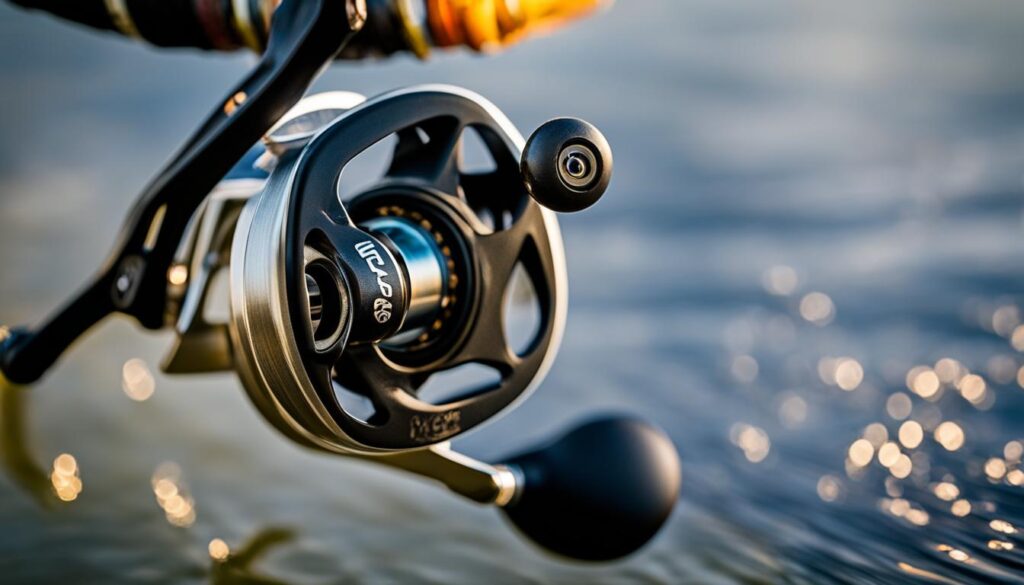
By understanding and utilizing baitcasting reel drag systems effectively, anglers can maximize their fishing success. Setting the drag properly, adjusting it based on fish size and line strength, and performing regular maintenance are essential for optimal drag performance. With the right baitcasting reel drag system, you can confidently tackle various fishing situations and make the most of your baitcasting reel.
Tips for Using Baitcasting Reel Drag Systems
If you’re using a baitcasting reel, understanding how to effectively use its drag system is essential for maximizing your fishing success. Here are some helpful tips to ensure you get the most out of your baitcasting reel drag:
1. Set the Drag Properly
To begin, make sure you set the drag properly before you start fishing. Adjust the drag to a level that is appropriate for your fishing situation, taking into account the strength of your fishing line and the size of the fish you’re targeting. A properly set drag will allow the fish to take line while still providing enough resistance to tire it out.
2. Make Gradual Adjustments
If you find yourself hooked onto a stronger or bigger fish, it’s important to be able to make adjustments to your drag on the fly. Instead of making sudden and drastic changes, make gradual adjustments to accommodate the increased pressure. This will help prevent your line from breaking and give you better control over the fish.
3. Regular Maintenance
To ensure your baitcasting reel drag system remains effective, it’s crucial to perform regular maintenance. Clean and lubricate the drag system periodically to keep it functioning smoothly. This will help prolong the life of your reel and ensure optimal performance when you’re out on the water.
By following these tips, you can maximize the effectiveness of your baitcasting reel drag system and improve your overall fishing experience. Remember to set the drag properly, make gradual adjustments when needed, and regularly maintain your reel for optimal performance. Happy fishing!
Conclusion
In conclusion, fishing reel drag systems are crucial components that allow you to control the tension on your fishing line when a fish is pulling. By preventing line breakage and allowing you to tire out the fish over time, drag systems greatly increase your chances of successfully landing your catch.
Understanding the different types of drag systems, such as front and rear drags for spinning reels or star-shaped knobs for baitcasting reels, helps you choose the right reel for your specific fishing needs. Properly setting up and adjusting the drag based on the size of the fish you’re targeting is essential for optimal performance.
Using drag effectively involves setting it at the appropriate level, making adjustments on the fly when necessary, and regularly testing and maintaining the drag system of your reel. By doing so, you can maximize the benefits of a good drag system and enhance your overall fishing experience.
FAQ
What is the purpose of a drag system on a fishing reel?
The drag system on a fishing reel allows anglers to control the tension on the line when a fish is pulling. It helps prevent the line from breaking and allows the angler to tire out the fish over time.
What types of drag systems are available for fishing reels?
There are different types of drag systems available, including front and rear drags for spinning reels, star-shaped knobs for baitcasting reels, and magnetic drag systems.
How do I set up and adjust the drag on my fishing reel?
Start by identifying the type of drag system your reel has, whether it’s a front drag, rear drag, or star-shaped knob. Adjust the drag setting based on the size of the fish you’re targeting, with lighter drag for smaller fish and higher drag for larger or heavier fish.
What are the different types of drag systems used in fishing reels?
Different types of drag systems are used in fishing reels to suit different fishing techniques and species. Fly reels typically feature disc drag systems, while spinning reels have front or rear drags. Spincast reels use star-shaped knobs for drag adjustment, while baitcaster reels have their unique drag system using centrifugal force.
Why is drag important in fishing?
Drag is important in fishing as it helps prevent line breakage, allows anglers to tire out the fish, reduces wear and tear on fishing reels, and provides more control over larger or stronger fish.
How can I use drag effectively in fishing?
Using drag effectively involves setting the drag properly and adjusting it on the fly when necessary. Set the drag to the appropriate level based on line strength and fish size, and make gradual adjustments during the fight to handle stronger or bigger fish.
Why do baitcasting reel drag systems matter?
Baitcasting reel drag systems play a crucial role in controlling the resistance when reeling in fish. They prevent line breaks, enhance casting accuracy and control, and ensure smooth line flow.
What are the different types of baitcasting reel drag systems?
Baitcasting reel drag systems can be star drag systems, magnetic drag systems, carbon fiber drags, hybrid drags, or centrifugal drags.
Any tips for using baitcasting reel drag systems effectively?
Set the drag properly based on line strength and fish size, and make gradual adjustments on the fly to handle stronger fish. Regularly maintain and clean the drag system to ensure optimal performance.
What is the importance of understanding fishing reel drag systems?
Understanding fishing reel drag systems helps anglers choose the right reel for their specific fishing needs and improves their chances of successfully landing fish.

